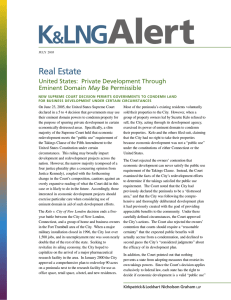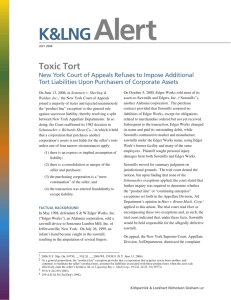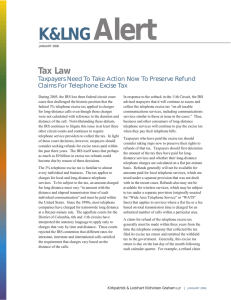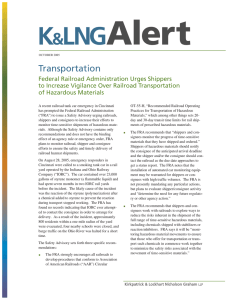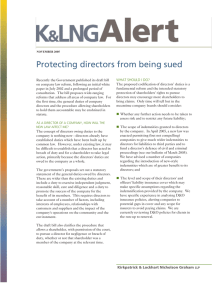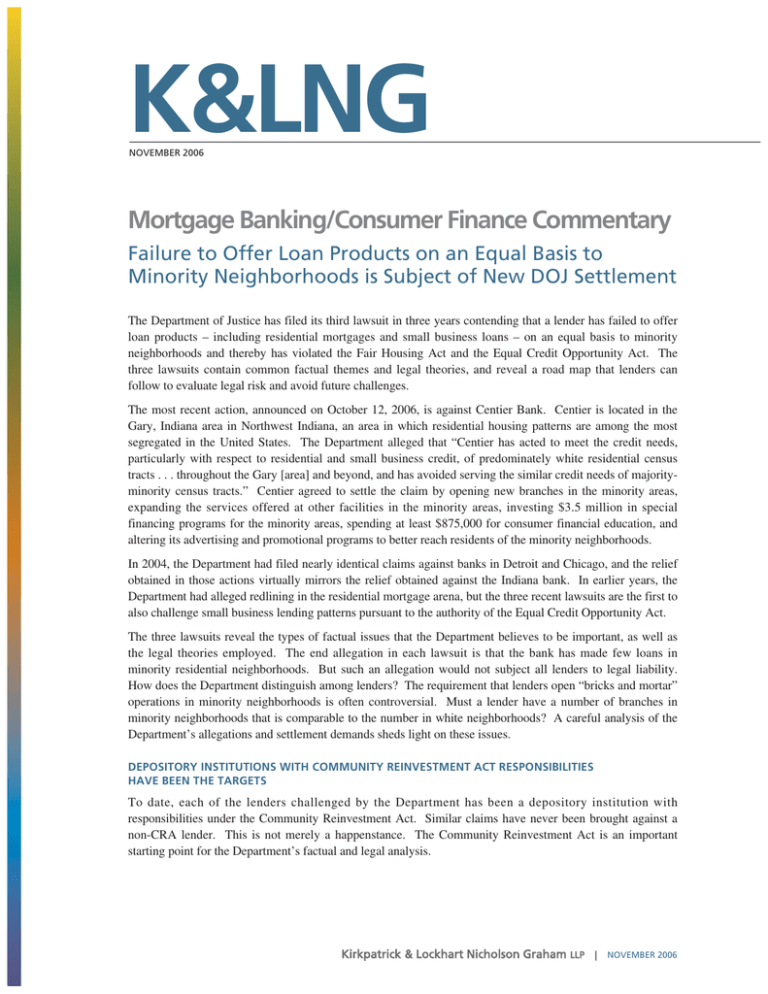
K&LNG
NOVEMBER 2006
Mortgage Banking/Consumer Finance Commentary
Failure to Offer Loan Products on an Equal Basis to
Minority Neighborhoods is Subject of New DOJ Settlement
The Department of Justice has filed its third lawsuit in three years contending that a lender has failed to offer
loan products – including residential mortgages and small business loans – on an equal basis to minority
neighborhoods and thereby has violated the Fair Housing Act and the Equal Credit Opportunity Act. The
three lawsuits contain common factual themes and legal theories, and reveal a road map that lenders can
follow to evaluate legal risk and avoid future challenges.
The most recent action, announced on October 12, 2006, is against Centier Bank. Centier is located in the
Gary, Indiana area in Northwest Indiana, an area in which residential housing patterns are among the most
segregated in the United States. The Department alleged that “Centier has acted to meet the credit needs,
particularly with respect to residential and small business credit, of predominately white residential census
tracts . . . throughout the Gary [area] and beyond, and has avoided serving the similar credit needs of majorityminority census tracts.” Centier agreed to settle the claim by opening new branches in the minority areas,
expanding the services offered at other facilities in the minority areas, investing $3.5 million in special
financing programs for the minority areas, spending at least $875,000 for consumer financial education, and
altering its advertising and promotional programs to better reach residents of the minority neighborhoods.
In 2004, the Department had filed nearly identical claims against banks in Detroit and Chicago, and the relief
obtained in those actions virtually mirrors the relief obtained against the Indiana bank. In earlier years, the
Department had alleged redlining in the residential mortgage arena, but the three recent lawsuits are the first to
also challenge small business lending patterns pursuant to the authority of the Equal Credit Opportunity Act.
The three lawsuits reveal the types of factual issues that the Department believes to be important, as well as
the legal theories employed. The end allegation in each lawsuit is that the bank has made few loans in
minority residential neighborhoods. But such an allegation would not subject all lenders to legal liability.
How does the Department distinguish among lenders? The requirement that lenders open “bricks and mortar”
operations in minority neighborhoods is often controversial. Must a lender have a number of branches in
minority neighborhoods that is comparable to the number in white neighborhoods? A careful analysis of the
Department’s allegations and settlement demands sheds light on these issues.
DEPOSITORY INSTITUTIONS WITH COMMUNITY REINVESTMENT ACT RESPONSIBILITIES
HAVE BEEN THE TARGETS
To date, each of the lenders challenged by the Department has been a depository institution with
responsibilities under the Community Reinvestment Act. Similar claims have never been brought against a
non-CRA lender. This is not merely a happenstance. The Community Reinvestment Act is an important
starting point for the Department’s factual and legal analysis.
Kirkpatrick & Lockhart Nicholson Graham LLP |
NOVEMBER 2006
In Centier, the Department alleged that, for many years, the bank defined its CRA assessment area to exclude
the minority neighborhoods of the metropolitan area in which it was located. The Department alleged that this
assessment area failed to conform with Regulation BB, which requires that a large bank assessment area
include one or more metropolitan areas or contiguous political subdivisions unless the area would be
extremely large, of unusual configuration, or divided by significant geographic barriers. The Department’s
allegation was aided by action of the FDIC, which, in 1999, had required the bank to redraw its assessment
area so as to include the minority areas. Very similar allegations were made against the banks in Detroit and
Chicago. In fact, the Chicago lawsuit resulted from a referral to the Department from the Federal Reserve
Board, after the Board lowered the bank’s CRA rating to “Substantial Noncompliance.”
It does not appear that the Department is contending that a violation of the CRA, by itself, constitutes a
violation of the Fair Housing Act or the Equal Credit Opportunity Act. But, if minority residential areas are
excluded from a defined assessment area when Regulation BB would seem to require the inclusion of such
areas, the Department will view such action as evidence of an intention to select areas for service on the basis
of race or national origin. This theory is evident in each of the three cases. It also is evident that the
Department has worked in tandem with regulators in addressing the CRA issue.
Once a CRA assessment area has been defined in conformity with Regulation BB, the Department examines
the bank’s performance in meeting the credit needs of the entire assessment area, including the credit needs of
low to moderate income neighborhoods. The particular focus of the Department is the performance of the
bank in meeting the credit needs of minority residential areas.
In sum, the CRA provides the framework in which the Department’s analysis is conducted. Federal law and
regulation impose obligations on banks to define the areas that they will serve and then to help meet the credit
needs of all portions of the defined areas. Not every violation of the CRA will constitute a violation of the
Fair Housing Act or the Equal Credit Opportunity Act. But to the extent that the CRA violation arises from a
failure to include geographic areas, or a failure to serve otherwise included geographic areas, in a manner that
is correlated with race or national origin, the Department will view the violation also as evidence of intent to
discriminate on the basis of race or national origin in violation of the Fair Housing Act and the Equal Credit
Opportunity Act.
ACTUAL LOAN APPLICATIONS AND ORIGINATIONS MAY BE THE MOST IMPORTANT FACTORS
While the CRA might provide the framework for the analysis in that it imposes a legal obligation to offer
credit services in defined areas, the most important issue is the extent of lending activity in the minority areas.
Thus, in each case, the Department has examined the volume of loan applications received from the minority
areas of the total geography that the bank is, or should be, serving. In each of the cases, the Department
concluded that the lender received few applications from the minority areas and originated few loans in those
areas. For example, in Centier the Department alleged that the bank made only 248 loans in the minority area
over a five year period, and further alleged that peer lenders were making many more loans in these same
residential areas.
The Department likes to present its allegations using maps as demonstrative aids. The maps, attached as
exhibits to the complaints, depict the geographic area in which the bank operates and are color-coded to reveal
minority residential concentrations. The location of the property that is the subject of each loan application or
origination is depicted by a dot. The density of the dots in white residential areas as compared to minority
residential areas reveals the point that the Department is seeking to establish. Similar maps have been used in
each case. An example of a map appended to the Centier complaint is attached hereto.
The allegations regarding loan applications and originations from minority areas may be the most crucial
allegations of the Department’s complaints. If the banks had been receiving applications and originating loans
in the minority areas in closer proportion to the minority neighborhood share of the total assessment area, it
would be much more difficult for the Department to allege redlining, even against banks that were
experiencing CRA difficulties with their regulators.
2
Kirkpatrick & Lockhart Nicholson Graham
LLP
|
NOVEMBER 2006
However, the Department does not rest its charge solely on the loan origination data. Rather, in each lawsuit,
the Department has alleged that other components of the bank’s operations evidence an intent not to serve
minority residential areas.
THE SIGNIFICANCE OF BRANCHING ACTIVITIES
Perhaps the most controversial of the Department’s allegations in these cases has been the challenge to
branching activities and the remedial requirement to open “bricks and mortar” branches in minority
neighborhoods. Many would argue that such a requirement is an unnecessary, unwarranted and costly
intrusion into a bank’s operation.
The Department seems to be of the view, however, that, in these three cases, branching was a method chosen
by the banks to attract customers and market their loan products. In Centier, the Department alleged that “a
major component of the Bank’s expansion has been the construction or acquisition of additional branch
offices, which are designed both to better serve existing customers and to attract new customers for Centier’s
services and products.” The Department further contended that the Indiana bank only opened branches in
minority residential areas when it was pressured to do so by its regulator, the FDIC. Additionally, it was
contended that the bank utilized in-store supermarket branches in minority neighborhoods and that such
branches did not offer the full range of banking services as did other branches.
Once again, the Indiana complaint mirrors the allegations of the earlier lawsuits. In the Detroit case, the
Department alleged that the bank “declined to open branches in the City of Detroit . . . so as to avoid serving
that community.” In Chicago, the Department alleged that “the Bank continued its race and national originbased pattern of adding or acquiring new branches to serve only white communities.” In addition, in Chicago
the Department alleged that the bank implemented a practice of using full-service ATMs (deposit taking and
cash dispensing) in white residential areas while using only cash dispensing ATMs in minority areas.
OTHER MARKETING EVALUATED BY THE DEPARTMENT
In each of the cases, the Department has challenged the marketing practices of the banks and presented
allegations that marketing was directed to the white community. In Chicago, for example, the Department
alleged that the bank “solicited credit transactions through a variety of discriminatory means, including, but
not limited to, the use of mortgage brokers serving white communities in the Chicago region.” In both
Chicago and Indiana, the Department criticized the banks’ focus of radio and print advertising on “general
audiences” and a failure to utilize minority format outlets.
ACTIONS EXPECTED IN THE FUTURE
Three lawsuits in three years with nearly identical factual and legal allegations certainly confirm the
Department of Justice’s focus on redlining. While other issues, such as loan pricing, are know to be the
subject of the Department’s fair lending inquiries, there is no reason to expect a letup on the redlining focus.
It can also reasonably be expected that depository institutions with responsibilities under the Community
Reinvestment Act will continue to be the primary targets. The CRA defines the legal obligations of the
banks, and a failure to meet those obligations in a manner that is correlated with race or ethnicity, in large
part, is the basis for the Department’s allegations of redlining. Regulators likely will continue to play an
important role in the events leading to such lawsuits.
That is not to say that nonbank lenders – without CRA responsibilities – are completely off the radar screen.
But such a challenge against a lender without CRA responsibilities would require an alternative legal
analysis. Such lenders do not start with an obligation to serve any particular community, and thus the mere
fact that they do not operate in minority neighborhoods does not indicate that their actions are illegal. It is
safe to assume that the Department believes that cases of this type require proof of intentional discrimination,
and markedly different elements of proof likely would have to be utilized against the non-CRA lender.
3
Kirkpatrick & Lockhart Nicholson Graham
LLP
|
NOVEMBER 2006
The Department has previously expressed the view that non-CRA lenders retain the right to focus on certain
“niche” markets without running afoul of fair lending laws, so long as the lenders do not adopt their “niche”
markets under circumstances from which a discriminatory purpose could fairly be inferred, and so long as
they serve their “niche” markets in a nondiscriminatory manner. If such lenders are to be challenged, the
proof may well include more evidence of overt discrimination – that might reveal discriminatory intent – than
the actions that have been filed to date.
There also is no sign that the Department will back away from its demands that banks open branches in
minority neighborhoods in factual situations similar to those presented in the three recent cases. At the same
time, the lawsuits do not appear to reflect a view that all CRA institutions risk fair lending challenge if they do
not have a minimum number of branches in minority neighborhoods. Again, the important issue is whether
the bank is properly serving the credit needs of minority neighborhoods, not the number of branches in the
minority neighborhoods.
It is theoretically possible that a bank could be challenged for redlining even if it had a large number of
branches in minority neighborhoods but was refusing to make home mortgage loans or small business loans in
minority areas. Similarly, a bank with no branches in minority neighborhoods may still fairly meet the home
mortgage needs and small business credit needs of minority areas by operating from a central location. Other
CRA issues may arise with the regulators, but the role of the Department of Justice in enforcing the Fair
Housing Act and the Equal Credit Opportunity Act is not implicated so long as the institution’s credit
programs are fairly available in minority neighborhoods.
ACTIONS TO REDUCE RISK
A fair lending compliance program presents many difficult challenges to lenders. Compared to complex
issues such as possible discrimination in loan pricing, it is significantly easier to avoid redlining claims.
Obviously, lenders with CRA responsibilities should pay particular heed. It is advisable to review assessment
area boundaries, even without prodding from regulators, to ensure that they are drawn in conformity with
Regulation BB. Red flags should arise if only certain areas of a city, county, or metropolitan area are
excluded from the assessment area and such excluded areas are inhabited primarily by minorities.
When a lender is confident that its CRA assessment area is drawn in a racially and ethnically fair manner, it can
examine its loan applications and originations by geographical areas within the assessment area. Fair lending
software is readily available to join HMDA data with Census data and produce maps that are the same product
that the Department of Justice believes to be so important in its actions. Just as the maps can be used to tell a
negative story, they can be used to tell a positive story. The map provides a snapshot of a lender’s performance.
Data regarding applications and originations in minority areas can be compared to the performance of peers,
as revealed by HMDA reports, and thereby help a lender evaluate its own performance. In the event that a
lender concludes that it is not servicing the areas to the extent that might be reasonably expected, it can look
for the cause.
Branching may play a role, particularly for those lenders who offer their credit products primarily through
branch locations. But it may not be necessary to jump to a conclusion that additional branches are needed
simply because performance is not at an acceptable level. Other devices might be considered, such as
outreach to real estate personnel serving the minority areas or targeted print or radio advertising.
A lender may find it more effective to open an office specializing in mortgage loans or business credit than to
open a full-service branch. This is not to minimize the importance of branching from a regulatory or fair
lending perspective, but rather to emphasize that there are alternative methods of addressing specific issues.
Regulators and the Department of Justice likely would look favorably on lenders who conduct this type of risk
assessment and use it as a guide to improve their enforcement program.
4
Kirkpatrick & Lockhart Nicholson Graham
LLP
|
NOVEMBER 2006
Finally, non-CRA lenders should not lose sight of the redlining issue. While they have not been the target to
date, it is foreseeable that they could be in the future. Continued analysis of higher-priced lending already has
raised concerns regarding the geographic areas served by lenders and the prices charged to minority
consumers as compared to the prices charged to non-minority consumers. No enforcement actions have yet
been filed but it is reasonable to expect that such actions may include challenges to marketing programs. Just
as banks conduct analyses of their branching programs, non-CRA lenders might conduct an analysis of their
office locations and marketing programs to evaluate whether they might face a claim of illegal redlining.
If you have any questions about this Alert, please contact Paul F. Hancock (305.539.3378 /
phancock@klng.com) or any member of K&LNG’s Mortgage Banking/Consumer
Finance Group.
5
Kirkpatrick & Lockhart Nicholson Graham
LLP
|
NOVEMBER 2006
MORTGAGE BANKING/CONSUMER FINANCE PRACTICE
Kirkpatrick & Lockhart Nicholson Graham LLP has approximately 1,000 lawyers who practice in offices located in Boston, Dallas,
Harrisburg, London, Los Angeles, Miami, Newark, New York, Palo Alto, Pittsburgh, San Francisco, and Washington. K&LNG
represents entrepreneurs, growth and middle market companies, capital markets participants, and leading FORTUNE 100 and
FTSE 100 global corporations, nationally and internationally.
For more information, please visit our website at www.klng.com or contact one of the lawyers listed below.
ATTORNEYS
Laurence E. Platt
Phillip L. Schulman
Costas A. Avrakotos
Melanie Hibbs Brody
Steven M. Kaplan
Jonathan Jaffe
H. John Steele
R. Bruce Allensworth
Irene C. Freidel
Nanci L. Weissgold
Paul F. Hancock
Phillip John Kardis II
Stephen E. Moore
Stanley V. Ragalevsky
David L. Beam
Emily J. Booth
Krista Cooley
Eric J. Edwardson
Suzanne F. Garwood
David Keith Gaston
Anthony C. Green
Laura A. Johnson
Kris D. Kully
Drew A. Malakoff
David G. McDonough, Jr.
Erin Murphy
202.778.9034
202.778.9027
202.778.9075
202.778.9203
202.778.9204
415.249.1023
202.778.9489
617.261.3119
617.951.9154
202.778.9314
305.539.3378
202.778.9401
617.951.9191
617.951.9203
202.778.9026
202.778.9112
202.778.9257
202.778.9387
202.778.9892
202.778.9061
202.778.9893
202.778.9249
202.778.9301
202.778.9086
202.778.9207
415.249.1038
lplatt@klng.com
pschulman@klng.com
cavrakotos@klng.com
mbrody@klng.com
skaplan@klng.com
jjaffe@klng.com
jsteele@klng.com
ballensworth@klng.com
ifreidel@klng.com
nweissgold@klng.com
phancock@klng.com
pkardis@klng.com
smoore@klng.com
sragalevsky@klng.com
dbeam@klng.com
ebooth@klng.com
kcooley@klng.com
eedwardson@klng.com
sgarwood@klng.com
dgaston@klng.com
agreen@klng.com
laura.johnson@klng.com
kkully@klng.com
dmalakoff@klng.com
dmcdonough@klng.com
emurphy@klng.com
Lorna M. Neill
Stephanie C. Robinson
Kerri M. Smith
Holly M. Spencer
Erin E. Troy
Staci P. Newman
Elwood F. Collins
Steve H. Epstein
Nadya N. Fitisenko
Brian M. Forbes
Thomas J. Poletti
Thomas C. Russler
202.778.9216
202.778.9856
202.778.9445
202.778.9853
202.778.9384
202.778.9452
212.536.4005
212.536.4830
617.261.3173
617.261.3152
310.552.5045
212.536.4068
lneill@klng.com
srobinson@klng.com
ksmith@klng.com
hspencer@klng.com
etroy@klng.com
snewman@klng.com
ecollins@klng.com
sepstein@klng.com
nfitsenko@klng.com
bforbes@klng.com
tpoletti@klng.com
trussler@klng.com
DIRECTOR OF LICENSING
Stacey L. Riggin
202.778.9202 sriggin@klng.com
REGULATORY COMPLIANCE ANALYSTS
Dana L. Lopez
202.778.9383 dlopez@klng.com
Nancy J. Butler
202.778.9374 nbutler@klng.com
Marguerite T. Frampton 202.778.9253 mframpton@klng.com
Jeffrey Prost
202.778.9364 jprost@klng.com
Allison A. Rosenthal
202.778.9894 arosenthal@klng.com
Brenda R. Kittrell
202.778.9049 bkittrell@klng.com
Joann Kim
202.778.9421 jkim@klng.com
Teresa Diaz
202.778.9852 tdiaz@klng.com
Robin L. Dinneen
202.778.9481 rdinneen@klng.com
www.klng.com
BOSTON • DALLAS • HARRISBURG • LONDON • LOS ANGELES • MIAMI • NEWARK • NEW YORK • PALO ALTO • PITTSBURGH • SAN FRANCISCO • WASHINGTON
Kirkpatrick & Lockhart Nicholson Graham (K&LNG) has approximately 1,000 lawyers and represents entrepreneurs, growth and middle market companies, capital
markets participants, and leading FORTUNE 100 and FTSE 100 global corporations nationally and internationally.
K&LNG is a combination of two limited liability partnerships, each named Kirkpatrick & Lockhart Nicholson Graham LLP, one qualified in Delaware, U.S.A. and
practicing from offices in Boston, Dallas, Harrisburg, Los Angeles, Miami, Newark, New York, Palo Alto, Pittsburgh, San Francisco and Washington and one
incorporated in England practicing from the London office.
This publication/newsletter is for informational purposes and does not contain or convey legal advice. The information herein should not be used or relied upon in
regard to any particular facts or circumstances without first consulting a lawyer.
Data Protection Act 1988—We may contact you from time to time with information on Kirkpatrick & Lockhart Nicholson Graham LLP seminars and with our regular
newsletters, which may be of interest to you. We will not provide your details to any third parties. Please e-mail london@klng.com if you would prefer not to
receive this information.
© 2006 KIRKPATRICK & LOCKHART NICHOLSON GRAHAM LLP. ALL RIGHTS RESERVED.



